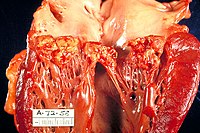
Photo from wikipedia
Abstract Background The standard treatment duration in low-risk Staphylococcus aureus bloodstream (SAB) is 14 days. However, it is unclear whether an extended course of antimicrobial therapy is necessary in patients… Click to show full abstract
Abstract Background The standard treatment duration in low-risk Staphylococcus aureus bloodstream (SAB) is 14 days. However, it is unclear whether an extended course of antimicrobial therapy is necessary in patients with clinically uninfected prosthetic joints/osteosyntheses or pacemakers/automated implanted cardioverter-defibrillators (AICDs). Thus, we compared the duration of antimicrobial therapy and outcomes in patients with and those without clinically uninfected foreign bodies. Methods We conducted a post hoc analysis of data from the prospective Invasive Staphylococcus aureus Infection Cohort (INSTINCT) study. Adult low-risk patients who survived ≥4 days were assessed for duration of treatment, SAB-related events (attributable death, relapse, or new deep-seated infection), and survival. Results Of the 1288 patients enrolled, 292 satisfied criteria for low-risk SAB. Forty-three patients (15%) had a clinically uninfected pacemaker/AICD or orthopedic implant. Patients with foreign bodies were significantly older (mean age, 72 vs 62 years for those without; P < .001; P = .9) and had a higher Charlson score (median, 3 vs 2; P = .06). The total duration of antimicrobial therapy (median, 18 vs 17 days, respectively; P = .7), all-cause mortality rate (16% vs 14%; P = .7), and prevalence of SAB-related events within 90 days were similar (2% vs 2%) in the 2 groups. At 1-year follow-up, SAB-related events were more frequent in patients with foreign bodies (7% vs 4% in those without; P = .4) (hazard ratio, 1.41; 95% confidence interval, .35–5.69; in a multivariable Cox model), but this difference was not statistically significant. Conclusions Low-risk patients with clinically uninfected foreign bodies received a similar duration of antimicrobial therapy without a significant impact on mortality rate. The observed higher hazard ratio of SAB-related events within 1 year necessitates additional studies before recommendations concerning treatment duration in this patient subgroup can be adapted or modified.
Journal Title: Open Forum Infectious Diseases
Year Published: 2019
Link to full text (if available)
Share on Social Media: Sign Up to like & get
recommendations!